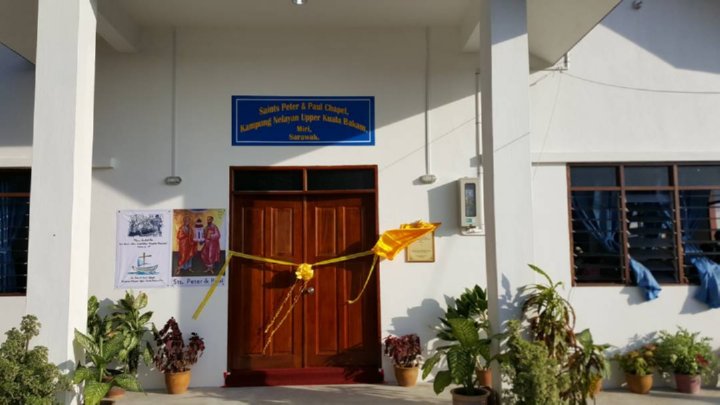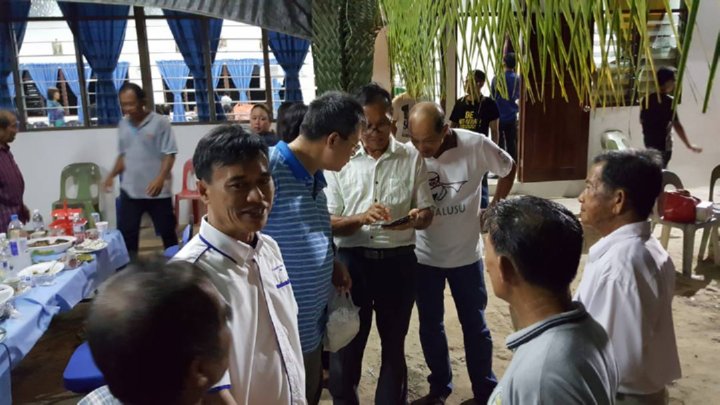Blessing of new Saints Peter and Paul Chapel
at Kampung Nelayan, Upper Kuala bakam
on 30th July 2017
on 30th July 2017
by Rt Rev Bishop Richard Ng.
Photography- Alvin Wong.
Story compiled by Ben Chang
Around 250 parishioners mainly Melanau community participated in the blessing and Mass service follow by a dinner after the Mass outside the chapel compound.
Known as the land below the wind, the Melanaus have been thought to be amongst the original settlers of Sarawak. They make up some 6% of the population in Sarawak. Today the population of Sarawak stands at 2.63 million (2015)
Originally from Mukah (the 10th Administrative Division as launched in March 2002), the Melanaus traditionally lived in tall houses. Nowadays, they have adopted a Malay lifestyle, living in kampong-type settlements. Traditionally, Melanaus were fishermen and still today, they are reputed as some of the finest boat-builders and craftsmen.
While the Melanaus are ethnically different from the Malays, their lifestyles and practices are quite similar. This is especially the case in the larger towns and cities.The Melanaus were believed to originally summon spirits in a practice verging on paganism. Today most of the Melanaus are Muslims whilst some were converted to Christianity (especially around Mukah & Dalat areas). However some still celebrate traditional animist festivals such as the annual Kaul Festival in Mukah District.
In 1980 the population of Sarawak was 1,233,103. The Melanau numbered was 69,578, of whom 53,689 were Muslim; 8,486 were Christian; 1,749 were tribal; and 5,328 were registered as having no religion, which in practice means they adhered to tribal religion(but were probably all tribal), and 326 were listed as miscellaneous.
Few reliable historical records of the Melanau exist before the nineteenth century, although European travelers and map-makers placed names not unlike "Melanau" on the northwest coast of Borneo. There are also probable references to the Melanau even earlier in Chinese records. The Coastal Melanau and the Kajang groups in the interior relate that their ancestors migrated from central Borneo and founded a Kajang kingdom from which the Coastal Melanau broke away. The Coastal Melanau believe that much of their culture and many of their institutions are derived from the legendary empire of the folk hero Tugau, who was overthrown in a struggle with Brunei. Some historians suggest that these events occurred in the fourteenth century, others, as early as the seventh. In 1861 the Melanau coastal district was ceded to James Brooke, the rajah of Sarawak, by the sultan of Brunei.
Beliefs and Spirituality
Traditionally they believe the world consists of this, the middle world, the upper world (the sky), and the world below. Traditionally the world was egg-shaped, seven layers or worlds above and seven below the middle world, the whole being balanced on the head of a buffalo standing on a snake, all surrounded by water. The breathing of the buffalo caused the ebb and flow of the tides. For some people the land of the dead was an underworld; others thought it elsewhere, but did not know where.
The world, the sun, the moon, and the stars were created by Alla-taala, but how is not known. He is remote and little interested in human affairs. All "layers" of the world are inhabited by spirits ( tou ), who, together with humans, animals, and plants, share this middle world. Every being has its own proper place in the world, which is ordered by adat. Overstepping boundaries causes trouble, and most human illness is caused by trespassing on some spirit's living space. Spirits are of many kinds: earth, air, water, forest, etc. Sometimes they are referred to as ipu', who are less malevolent than tou, and may indeed be invited to reside in and protect dwellings. Supernaturals live on the moon and punish disorderly and disrespectful behavior by men, especially mockery of animals. A female guards the entrance to the land of the dead. People are reluctant to call such supernaturals "tou" or "ipu'," but no other term exists for such demigods. Muslims and some pagans call them melaikat.
Religious Practitioners or pagan priests exist. Expert carvers of spirit images, or bilum, diagnose what spirit (sometimes also called "bilum" and not "tou") is likely to have caused an illness and, in a short ceremony, forces the spirit into its carved image so that it may be taken to its proper place and forbidden to harm the patient for at least three days. Spirit mediums, with the help of familiar spirits, also cure illness and practice divination. Every village holds an annual cleansing ceremony, kaul, to call uninvited spirits that have taken up residence in the village to a feast before they are sent home to their proper places.
Ceremonies. Apart from the annual kaul, private ceremonies of increasing complexity and expense are held for the curing of illness by spirit mediums. Ceremonies for the safety of a child two months before its delivery initiate a series of taboos, culminating in the birth. There are also ceremonies at the wake of a dead person; they may continue for several months, until a secondary burial.
Among most Melanau groups, tattooing was never widely practiced. Strongly built longhouses, fortresses thirty feet above ground, were traditionally decorated with elaborate wood carving. Bilum carved in sago pith were widely used and are a sophisticated form of sculpture. Ceremonies were accompanied by gong orchestras with distinctive chants and music; bards recited and sang epics, legends, and myths of considerable poetic merit at ceremonies or simply for entertainment.
Most illness was attributed to an attack by a spirit, but certain ailments, mostly minor, were attributed to a failure to keep a proper balance between hot and cold conditions in the body. Herbal medicines existed to restore the balance.
An individual's funeral is one of the most important events in the life cycle. At death the soul begins a boat journey, accompanied by attendant spirits—usually called "tou"—to the land of the dead. Chants, ceremonies, and games during the wake ensure the soul a safe journey. Once admitted, the soul is sent to one of seven pagan villages, appropriate to the manner of death, and lives a life similar to that of this middle world.
Eventually a second death occurs, and many believe that the soul then becomes dew. They believe that the soul sets out for the land of the dead by boat or, according to some, along a road that comes to a place where the path becomes a sword across a pot of blazing fire. An individual who has led a good life can walk along the flat edge of the sword; the sharp edge of the sword ensures that one who has led a bad life falls into the pot. Beyond the sword is the Jesus Christ and heaven.
Social Organization.
Formerly a village was an independent unit governed by a group of self-appointed aristocrats known as a-nyat, or elders. The rajah of Sarawak appointed one of them as headman, answerable to the district officer. Today the influence of the elders varies with local circumstances; their power is now primarily ceremonial, concerned with validating social mobility at weddings. The suppression of endemic tribal warfare by the rajah of Sarawak allowed people other than aristocrats to acquire wealth by planting sago gardens; the gradual introduction of a cash economy permitted commoners and even slaves to acquire wealth and make claim to higher rank and even enter the group of governing elders.
In villages social control is largely a matter of adat, or custom, supervised and administered by the headmen and elders. The Coastal Melanau Adat, an attempted codification of many village adats, is followed by headmen and elders in cases of family and personal dispute, short of homicide or criminal theft, but each village claims its own version of the adat and often does not adhere to the official codification. Social control, however, is maintained primarily by a value system that places a high premium on respect for seniority, rank, and the proper order of things as embodied in the adat, any violation of which entails civil penalties imposed by the elders and automatic supernatural penalties that can be averted only by correct reparation.
Conflict is usually seen as a disregard of proper respect, and children are brought up to avoid conflict at almost any cost.
Language and Culture
Melanau is an Austronesian language of the Western Malayo-Polynesian Branch. It has no standard orthography; today individuals use their own spelling and the roman script. The Melanau language is divided into dialects, not all of which are mutually intelligible. The Coastal and Rajang dialects are linguistically related to those of the Kajang groups and groups on the coast between Bintulu and Brunei and the interior, groups sometimes referred to as Kelemantan. All Melanau people, speak a Melanau dialect, although today most are bilingual in Malay and Melanau.
The population of a village is divided into aristocrats ( a-menteri ), commoners ( a-bumi), and slaves ( a-dipen ). Ideally marriage should be with a second cousin (patrior matrilateral) within the same rank; but in small, politically independent communities the need for talent has always favored cross-rank marriages.
The father of a bride is covertly permitted to choose the bride-wealth and rank he desires for his daughter through any line of descent. A wedding is the most important public occasion on which upward or downward mobility is recognized and validated. Theoretically, all first marriages are arranged by parents, but the wishes of the proposed partners are usually taken into consideration. Parents do not arrange second marriages. For a period after the wedding, uxorilocal residence is ideal, but economic advantage often overrides the ideal. One child, usually the youngest, is expected to remain with the parents.
Infants and children are reared by both parents, by siblings, and by other household members. Physical punishment is very rare; it is regarded as a debased practice. Individual independence is highly valued, but not at the expense of custom and respect for elderly people.
People who cook and cater together are considered to be a family (tegen) ; but a household may consist of several separate catering and cooking units. Six or seven people constitute an average household.
Property is divided equally among surviving children and the offspring of any dead children. The former longhouse apartment or the contemporary house, in addition to a share of other property, is usually allotted to the child who remains with the parents. Gardens and orchards are divided as whole units and are not subdivided.




















































